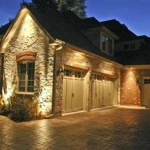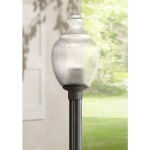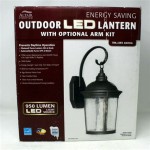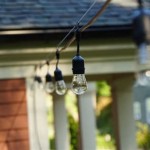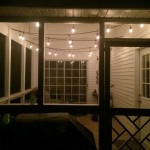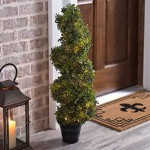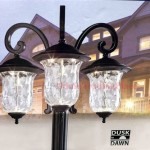Replacement Parts for Outdoor Lighting: Ensuring Longevity and Performance
Outdoor lighting enhances safety, aesthetics, and functionality for residential and commercial properties. Exposure to the elements, however, can lead to wear and tear, requiring replacement parts to maintain optimal performance. Understanding the common replacement parts available and their specific applications is crucial for property owners and maintenance professionals.
The lifespan of outdoor lighting fixtures can be significantly extended by proactively replacing worn or damaged components. Addressing issues promptly prevents further damage to the fixture itself and avoids potential safety hazards. This article provides a comprehensive overview of essential replacement parts for outdoor lighting, focusing on their functions, common issues, and replacement considerations.
Bulbs and Lamps: Illuminating the Night
The light source itself, whether a bulb or a lamp, is arguably the most frequently replaced component in outdoor lighting systems. Technological advancements have introduced a variety of options, each with distinct characteristics regarding energy efficiency, lifespan, and light output. Traditional incandescent bulbs have largely been superseded by more efficient alternatives like halogen, compact fluorescent (CFL), and light-emitting diode (LED) options.
Halogen bulbs offer a brighter, whiter light compared to incandescent bulbs and have a slightly longer lifespan. However, they still consume significantly more energy than CFLs or LEDs. CFLs were initially popular due to their energy efficiency, but they contain mercury and have a longer warm-up time. LEDs have emerged as the dominant choice due to their exceptional energy efficiency, extended lifespan (often exceeding 25,000 hours), and instant-on capability. LEDs also offer a wide range of color temperatures, allowing for customization of the lighting ambiance.
Selecting the appropriate bulb or lamp requires careful consideration of several factors. First, the base type must match the fixture socket (e.g., E26, E12, GU10). Second, the wattage rating should be compatible with the fixture's specified maximum wattage to prevent overheating and potential fire hazards. Third, the desired light output, measured in lumens, should be sufficient for the intended application. For example, pathway lighting may require lower lumen output than security lighting.
Furthermore, the correlated color temperature (CCT), measured in Kelvin (K), influences the appearance of the light. Lower CCT values (e.g., 2700K-3000K) produce a warmer, yellowish light, while higher CCT values (e.g., 4000K-5000K) produce a cooler, bluer light. The choice of CCT depends on personal preference and the desired aesthetic. Finally, for fixtures controlled by dimmers, it is critical to use dimmable bulbs or lamps specifically designed for dimmer compatibility.
Photocells and Sensors: Automation and Efficiency
Photocells and sensors automate outdoor lighting operation, enhancing convenience and energy efficiency. Photocells, also known as dusk-to-dawn sensors, automatically turn lights on at dusk and off at dawn based on ambient light levels. This eliminates the need for manual switching and ensures that lights are only active when needed. Motion sensors, on the other hand, trigger lights only when motion is detected within a specific range. This is particularly useful for security lighting, as it deters potential intruders and conserves energy when there is no activity.
Photocells typically consist of a light-sensitive resistor that changes its resistance based on incident light. When light levels are low, the resistance increases, activating a relay that switches on the lights. Common issues with photocells include failure to turn on or off correctly, flickering, or complete malfunction. These issues can often be attributed to a faulty photocell itself, wiring problems, or obstructions blocking the sensor's view of ambient light.
Motion sensors utilize various technologies, including passive infrared (PIR), ultrasonic, and microwave sensors, to detect movement. PIR sensors detect changes in infrared radiation emitted by warm objects, while ultrasonic sensors emit sound waves and detect changes in their reflection patterns. Microwave sensors emit microwave radiation and detect changes in its frequency caused by moving objects. PIR sensors are generally the most common and economical choice for outdoor lighting applications.
When replacing photocells or motion sensors, it is important to select a compatible model with the appropriate voltage and wattage ratings for the existing lighting system. Proper installation is crucial for optimal performance. The sensor should be positioned in a location that is free from obstructions and shielded from direct sunlight, which can interfere with its operation. Regular cleaning of the sensor lens or surface can also help maintain its accuracy.
Transformers and Power Supplies: Regulating Voltage
Many outdoor lighting systems, particularly low-voltage landscape lighting, rely on transformers or power supplies to convert standard line voltage (e.g., 120V or 240V) to a lower voltage (e.g., 12V or 24V). This lower voltage is safer for outdoor use and allows for smaller, more discreet fixtures. Transformers and power supplies ensure a stable and consistent voltage supply to the lighting fixtures, preventing damage and ensuring optimal performance.
Transformers typically use electromagnetic induction to step down the voltage, while power supplies use electronic circuits to convert and regulate the voltage. Transformers are generally more robust and reliable but can be larger and heavier. Power supplies are more compact and energy-efficient but may be more susceptible to damage from power surges or overload conditions.
Common issues with transformers and power supplies include overheating, buzzing or humming noises, voltage fluctuations, and complete failure. These issues can be caused by overload conditions, wiring problems, exposure to moisture, or aging components. Overloading a transformer or power supply by connecting too many fixtures or fixtures with excessive wattage can lead to overheating and premature failure.
When replacing a transformer or power supply, it is essential to select a model with the appropriate voltage input and output ratings and sufficient wattage capacity to accommodate the total wattage of all connected fixtures. The replacement unit should also be designed for outdoor use and properly protected from the elements. Wiring connections should be secure and weatherproof to prevent corrosion and electrical hazards. It's crucial to consult with a qualified electrician for complex wiring or voltage compatibility concerns.
Lenses and Covers: Protection and Light Diffusion
Lenses and covers protect the light source from environmental elements such as rain, snow, dust, and insects. They also diffuse the light, creating a more even and aesthetically pleasing illumination. These components are typically made of glass, plastic, or polycarbonate, each offering different levels of durability and light transmission characteristics.
Glass lenses and covers offer excellent clarity and resistance to scratches and UV degradation. However, they are more fragile and susceptible to breakage. Plastic lenses and covers are more impact-resistant but can become cloudy or yellowed over time due to exposure to sunlight. Polycarbonate lenses and covers offer a good balance of durability, clarity, and UV resistance.
Common issues with lenses and covers include cracking, chipping, discoloration, and accumulation of dirt and debris. Cracks and chips can compromise the weather resistance of the fixture and allow moisture to enter, potentially damaging the light source and other internal components. Discoloration can reduce light output and alter the appearance of the light. Accumulated dirt and debris can also reduce light output and create a less appealing aesthetic.
When replacing lenses and covers, it is important to select a replacement that is specifically designed for the fixture model to ensure a proper fit and seal. Cleaning lenses and covers regularly with a mild detergent and water can help maintain their clarity and light transmission. Consider replacing plastic lenses with polycarbonate lenses for increased durability and UV resistance.
Wiring and Connectors: Electrical Integrity
The wiring and connectors within an outdoor lighting system are critical for ensuring reliable electrical conductivity and safety. Outdoor conditions can corrode and degrade wiring and connectors, leading to voltage drops, short circuits, and potential fire hazards. Proper wiring techniques and weather-resistant connectors are essential for maintaining the integrity of the electrical system.
Common types of wiring used in outdoor lighting include low-voltage landscape lighting cable and direct burial cable. Low-voltage landscape lighting cable is typically used for connecting low-voltage fixtures to a transformer or power supply. Direct burial cable is designed to be buried underground without the need for conduit and is used for connecting power to the transformer or other electrical components.
Connectors used in outdoor lighting must be weatherproof and corrosion-resistant to prevent moisture from entering the electrical connections. Common types of connectors include wire nuts with silicone sealant, heat-shrink connectors, and gel-filled connectors. These connectors provide a secure and watertight seal, protecting the wires from corrosion and preventing short circuits.
When replacing wiring or connectors, it is important to use the correct gauge wire for the application to ensure adequate current carrying capacity. Undersized wiring can overheat and cause voltage drops, affecting the performance of the lighting fixtures. All wiring connections should be secure and properly insulated to prevent shorts and electrical hazards. Consider using gel-filled connectors or heat-shrink connectors for added weather protection. If the wiring is damaged or corroded, it should be replaced entirely rather than attempting to repair it. Consultation with a qualified electrician is recommended for any complex wiring issues.

Round Mr16 Replacement Socket With 10 18 Awg Lead

Finials Vent Screens Rain Cap Shields Gas Regulator Chimney And Ceramic Burner Tip Parts For Gaslight Outdoor Street Yard Lamps Easy Living Home Systems

Outdoorlantern Gif 532 771

Solar Light Replacement Top Parts Waterproof Led Panel Lantern Cover For Hanging Garden Decoration Temu New Zealand

Where Can I Find Replacement Parts For An Old Solar Outdoor Lantern Hometalk

Kerr Lighting Replacement Parts Paverlightinternational

Parker Outdoor Replacement Glass Hanging Light Or Post Parts

2 Pieces Of Solar Light Replacement Top 3 15 X0 78 Led Used For Outdoor Chandelier Parts Com

Replacement Parts Wire Connector 12 14 Gauge Landscape Lighting Outdoor Lights

2 Pieces Of Solar Light Replacement Top 3 15 X0 78 Led Used For Outdoor Chandelier Parts Ca
Related Posts
